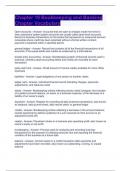Exam (elaborations)
Chapter 19 Bookkeeping and Banking Chapter Vocabulary Questions and Answers
- Course
- Institution
Chapter 19 Bookkeeping and Banking Chapter Vocabulary Open Accounts - Answer- Accounts that are open to charges made from time to time; physicians' patient patient accounts are usually called open-book accounts. Record of business transactions on the books that represents an unsecured account re...
[Show more]



